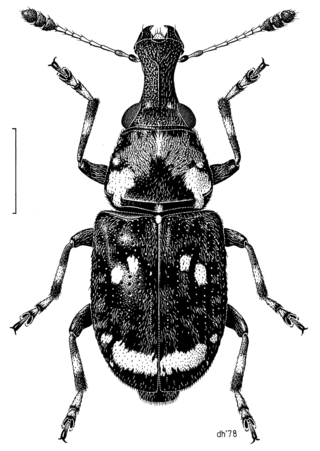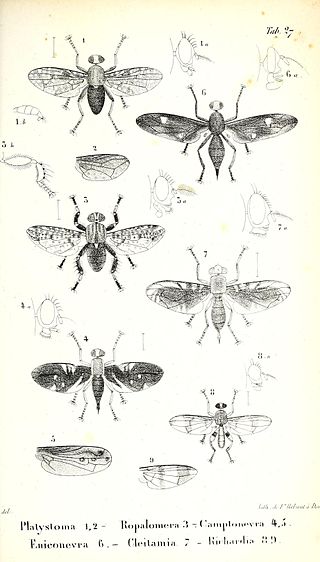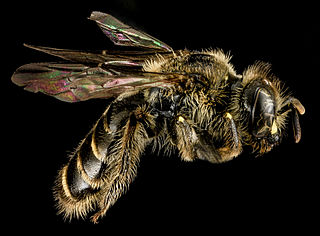
Anthribidae is a family of beetles also known as fungus weevils. The antennae are not elbowed, may occasionally be longer than the body and thread-like, and can be the longest of any members of Curculionoidea. As in the Nemonychidae, the labrum appears as a separate segment to the clypeus, and the maxillary palps are long and projecting.
The National Biodiversity Network (UK) (NBN) is a collaborative venture set up in 2000 in the United Kingdom committed to making biodiversity information available through various media, including on the internet via the NBN Atlas—the data search website of the NBN.

Caeciliusidae is a family of Psocodea belonging to the suborder Psocomorpha. The family was once named Caeciliidae, but the latter name was changed because of homonymy with the amphibian family Caeciliidae. The subfamily Paracaeciliinae was formerly in Caeciliusidae, but it has been elevated to family rank, Paracaeciliidae.
The World Register of Marine Species (WoRMS) is a taxonomic database that aims to provide an authoritative and comprehensive list of names of marine organisms.

The Ropalomeridae are a family of acalyptrate flies.

iNaturalist is an American 501(c)(3) nonprofit social network of naturalists, citizen scientists, and biologists built on the concept of mapping and sharing observations of biodiversity across the globe. iNaturalist may be accessed via its website or from its mobile applications. iNaturalist includes an automated species identification tool, and users further assist each other in identifying organisms from photographs and even sound recordings. As of 9 July 2024, iNaturalist users had contributed approximately 197,660,888 observations of plants, animals, fungi, and other organisms worldwide, and 290,007 users were active in the previous 30 days.

Schizopteridae is the largest family in the infraorder Dipsocoromorpha and comprises 56 genera and approximately 255 species. Schizopterids are some of the smallest (0.5–2.0 mm) true bugs. Members of this family can be distinguished by their small size, enlarged forecoxae and varying degree of abdominal and genitalic asymmetry in males. Schizopteridae exhibit a wide range of simple and complex wing venation patterns. The group is currently divided into three subfamilies: Schizopterinae, Ogeriinae and Hypselosomatinae.

Calliopsis is a genus of panurgine bees in the family Andrenidae. There are over 80 described species distributed throughout the western hemisphere.

Stictiella is a genus of sand wasps in the family Bembicidae. There are at least 14 described species in Stictiella.

Lindneromyia is a genus of flat-footed flies. There are at least 70 described species in Lindneromyia.

Dieunomia is a genus of sweat bees in the family Halictidae. There are about nine described species in Dieunomia. These bees are relatively uncommon, and are larger than almost every other genus in Halictidae other than Nomia. The wing has two submarginal cells, and the usual bent vein of the basal vein is only weakly present. The male has greatly dilated middle tarsi.
Ocnaea sequoia is a species of small-headed flies in the family Acroceridae.
Ocnaea is a genus of small-headed flies. There are 20 described species in Ocnaea.
Plenoculus is a genus of square-headed wasps in the family Crabronidae. There are more than 20 described species in Plenoculus.
Pulverro is a genus of aphid wasps in the family Ammoplanidae. There are about 13 described species in Pulverro.
Pherocera is a genus of stiletto flies in the family Therevidae. There are about 12 described species in Pherocera.

Protandrena is a genus of mining bees in the family Andrenidae. Depending upon whose definition of the genus one follows, there are anywhere from 50 to 180 described species in Protandrena; traditional classifications recognize 7 subgenera, some of which are sometimes elevated to genus rank, and other classifications place many of these species in the related genus Pseudopanurgus (e.g.), leaving Protandrena with a much smaller constituency. In the most inclusive definition, they are found from Canada through Argentina. However, there is current disagreement whether the Protandrena in South America belong to different genera, in which case the genus extends only as far south as Panama. They are solitary bees, but some species nest in aggregations. They prefer to nest in sunny areas with sparse vegetation. The underground nests have cells lined with a chemical substance. This "wallpaper" acts as a barrier between fungi and bacteria. The eggs hatch, the larvae develop, and then overwinter as mature larvae with hardened skin. They are primarily active from May to October, but have been noted to be active in April in the region six of the United States.

Timema boharti, or Bohart's timema, is a species of walkingstick in the family Timematidae. It is found in North America.
Ocnaea auripilosa is a species of small-headed flies in the family Acroceridae.










